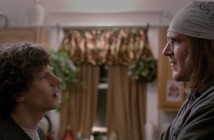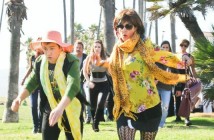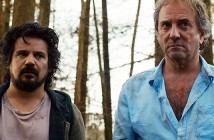
Cast: Adèle Exarchopoulos, Léa Seydoux, Jeremie Laheurte
Director: Abdellatif Kechiche
Country: France
Genre: Drama
Official Trailer: Here
Editor’s Notes: Blue is the Warmest Color opens in limited release on Friday, October 25th.
Where to begin? This three-hour opus has been the talk of Cannes since its debut earlier this week, and at the time of writing is the frontrunner to win the Palme d’Or. It had better. Tunisian filmmaker Abdellatif Kechiche has crafted a beautifully intimate film that introduces us to one of the most perfectly defined characters to appear in a movie in recent memory. La Vie d’Adèle (aka Blue Is the Warmest Colour) displays some of the most confident acting and storytelling imaginable.
Tunisian filmmaker Abdellatif Kechiche has crafted a beautifully intimate film that introduces us to one of the most perfectly defined characters to appear in a movie in recent memory.
Revelatory newcomer Adèle Exarchopoulos plays Adèle—named for the actress—a melancholy French 15-year-old dealing with the everyday pressures of being young and alive. She has awkward flirtations with boys, endures the teasing of friends, struggles with philosophy classes despite being an avid reader and suffers tedious, silent dinners with her working class parents. Things start looking up for Adèle when a handsome older student asks her out. But it’s while walking to their first date that she passes a ravishingly beautiful blue-haired lesbian, forming electric eye contact as their faces turn to one another, and then glance back and meet once more after they’ve each passed by. Adèle is shaken by the uncertainty the encounter presents her with, but presses ahead with her date. That night, she is startled to find herself visited by the teal-tinted stranger in her sleep; a passionate, graphic sex dream that leaves Adèle utterly confused and heartbroken.

Things go from bad to worse for Adèle; her first boyfriend soon provides her first breakup and schoolyard cattiness starts to get very ugly as her friends react shamefully to her budding sapphism. Soon however the blue-haired stranger reenters her life, and is introduced as aspiring painter Emma (Léa Seydoux). They flirt and chat and hang out, but soon their cosmic chemistry erupts in a passionate relationship, which the film follows over several years. The ups and downs are presented honestly and fluidly, and we see both Adèle and Emma grow in the relationship, and grow apart as Emma’s art career takes off and Adèle pursues her dream of becoming an educator.
Exarchopoulos, not yet 20 years old, is a divine discovery on Kechiche’s behalf, and remains a hypnotising presence for every one of the film’s 187 minutes, in which she is almost never off screen. Her puppy fat cheeks and always slightly agape mouth root her in a state of adolescence she is ready to escape. When she is happy her face lights up with a cheeky sexuality, and her mess of brown wavy hair falls down to her shoulders. But she is even more adept at conveying her character’s despair and heartbreak; when she wells up to cry you cannot help but cry with her. Seydoux is similarly excellent as the confident, sexy Emma, who is appreciable as both flawed human being and angelic object of desire. The chemistry between the pair is like nothing else seen before between two women on camera. There is an awkward moment in one of their first rendezvous where they must part but can neither bring themselves to leave nor to kiss one another; the camera lingers, the space between them pulses with energy and their faces say more about passion and desire than any words ever could. It is perhaps the most sexual moment ever captured on film.
When the pair first kiss, the film makes its first dramatic time leap to Exarchopoulos and Seydoux in bed together, in what turns out to be a ten minute sex scene.
When the pair first kiss, the film makes its first dramatic time leap to Exarchopoulos and Seydoux in bed together, in what turns out to be a ten minute sex scene. Nothing is left to the imagination as the actresses fully embrace one another’s bodies and sexualities. It is hardly pornographic, but a powerful scene of lovemaking earned by the remarkable performances and Kechiche’s rich layering of the sexual tension in the preceding scenes. The film is so full of depth and meaning that it will be the subject of countless articles and theses to come. The repeated theme of oral fixation is notable; one of our first scenes with Adèle sees her messily eating spaghetti, leaking sauce all over her mouth and chin. Later Emma teaches her to get over her fear of eating oysters, a metaphor for cunnilingus the film openly acknowledges. The actresses’ lips play as important a role in the film as their contrasting hair colours.
The lovers are gloriously lit by Kechiche and his crew, and shot in a gently wavering movements that recalls the documentary feel of The Class. You never quite feel like you’re watching a film, but experiencing someone else’s life, and are powerless to alter their actions. It is this mesmeric quality of the film and how it is shot that makes its daunting running time vanish into brief, beautiful moments.
The script, co-written by Kechiche and adapted loosely from a graphic novel by Julie Maroh, is truly incredible, with powerful dialogue that is often as witty as it can be laced with pain. The understanding of heartache, brought so magically and terribly to life by Exarchopoulos, is second to none, and anyone who has ever been through a breakup will find this difficult, familiar viewing. The fact that the couple are both women is, for the most part, irrelevant. The writers have also ingeniously chosen to eliminate that great satan of modern script writing—technology—removing almost all mobile phones and computers from the film. La Vie d’Adèle is set in the anytime, a world where storytelling comes first, stories that are honest to emotion, even if they are not honest to the trivialities and props of everyday life.
The film ends with the title card, adding the subtitle “Chapters 1 and 2”. We may meet Adèle again in another life. Who knows who she, or we, will be then.
[notification type=”star”]95/100 ~ AMAZING. An astounding work; heartbreaking, erotic, utterly true-to-life. The performances are faultless, the script burns with human feeling and passion.[/notification]



